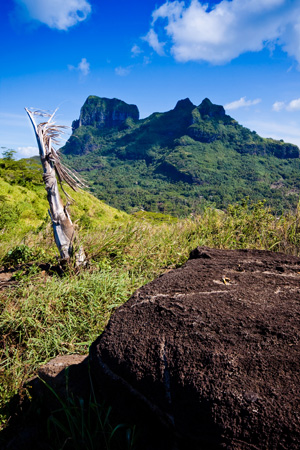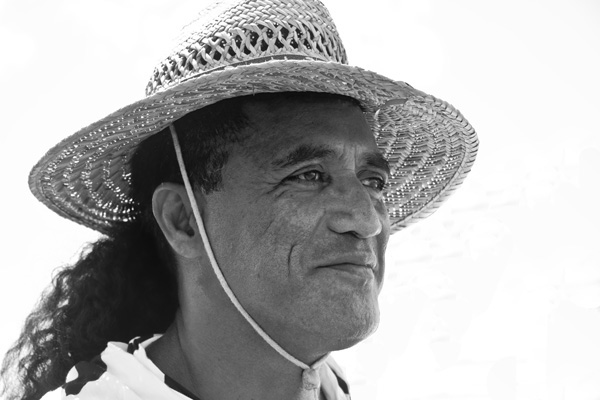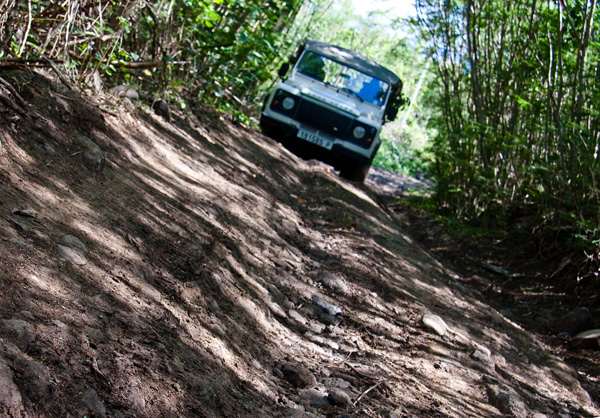BORA BORA, POLYNESIA - Our guide, Heifara Tairua drives the hilly roads that snake through Bora Bora deftly, intuitively — these hills have no secrets from him.
Roads? No … more like trails and paths cut through the thick brush. The Land Rover lurches forward and back, staying on the path we follow up the mountain.
Expertly guided by a steady hand, we try to relax while listening to tales of the island’s history, religious sites (marae) and sacred practices.
Born in Bora Bora in 1964, Heifara, who likes to be called “Patrick”, is a true son of the island. He’s an accomplished fire dancer (he represented his village at the annual national HEIVA contest) and is renowned for his skills with a traditional outrigger canoe.
He also has a deep knowledge of the sacred symbols and rites of Polynesian marriage – which allows him to officiate at vow renewals for visiting couples, bringing a personal touch of island energy to their love.
Patrick is a son of one of the island’s last village chiefs. His father then became mayor of his hometown, Anau. Patrick has worked as a labourer, in hospitality, in the military, and as a bus driver and tour guide. And he loves to show off his beautiful island.
“Bora Bora was known as Pora Pora, meaning ‘first born’, based on the Polynesian myth that it was the first of these islands drawn out of the sea after the creation of Raiatea by the gods,” he tells us.


Left: The island is an awesome sight. Right: Heifara Tairua is a local legend and guide.
Our intended destination is Popoti, one of Bora Bora’s highest vantage points. Along the way, we stop at an ancient sacred site called Marae Aehautai 2. The marae are places where priests of old would perform rituals, including animal --and sometimes human -- sacrifices. Each block or stone represents one sacrifice to the gods.
Patrick leads us through the deep forest, describing the tropical plants: ginger, mango, ylang ylang, coconuts, vanilla and wild hibiscus.
We come upon the Fare Opu marae, which features a turtle petroglyph.
“The turtle is considered sacred here,” says Patrick, “as it was a major source of food for centuries.”
Patrick tells us that Bora Bora was populated by people who made long sea voyages from other islands such as Fiji and Hawaii, carrying chickens, goats and dogs with them in their outrigger canoes.
The chickens and goats were brought as a food source, both for the journey and when they reached landfall. The dogs had a different job. They had the uncanny ability, Patrick says, to “know” which direction land was in … even before it was spotted by the explorers.
Skeptically, we ask if he really believes that, or if it’s just a local legend.
“It’s true,” he protests. “My mother and father talked about that and all islanders know it is a fact. The early people coming to this island depended on it for their survival.”
Moving on, we gaze at Mt. Otemanu, the island’s highest peak. Made from volcanic basalt, it looks like a giant tombstone sticking up from the centre of the island.
On the crest of a hill called Poopooureroa, we encounter some man-made giants: rust-eaten, but still impressive, remains of World War II cannons perched in their emplacements overlooking the lagoon as they did more than 60 years ago when Bora Bora was a vital U.S. army staging area for supplies destined for the Solomon Islands.

Above: You have to go off road to find Bora Bora’s inner beauty.
Our Land Rover strains up the steep path, pitted with potholes which sometimes reduce our progress to a crawl. Tree branches swat our faces and we rock from side to side as we push past the forest clinging to the side of the hills.
But the overwhelming view from Popoti more than makes up for the rough ride. From this vantage point we see the famous lagoon, with its deep blues and iridescent greens shimmering in the sun.
The lagoon is enclosed by a reef, the last vestiges of the volcano that created the island. This reef has many tiny islets, which are a magnet for modern-day explorers in catamarans, sailboats and other small craft.
Seeing our reaction to the scene, Patrick beams with pride … pride in his island and in his opportunity to share its rugged beauty, intimate history and culture with visitors.Visitors? After a day with Patrick, we feel like family.
About the Author

From tracking and naming a female Humpback Whale in Moorea, near Tahiti; in a hot air balloon adventure over the Napa wine valley, to visiting a native community two hours by canoe into the depths of the Ecuadorian Amazon, Mark has brought many adventure travel stories and images to readers across the country. A freelance contributor to TraveLife magazine, Mark also is a regular contributor of travel features to ExtraOrdinary Health Canada Magazine; and has been published in the Toronto Star, the National Post, and Air Canada’s EnRoute magazine, and in Photographer’s Forum: Best of Photography. Mark studied photography at Toronto’s Ryerson University. Mark’s been fortunate enough to travel to places many people dream of in addition to those mentioned previously; The Galapagos islands, Bora Bora, Taha’a, Raiatea, Costa Rica, extensively through the Caribbean, Puerto Rico, Mexico, Florida, California, Alberta, B.C., England and Scotland. Favorite spot? That’s a hard one – there have been so many but at the end of the day it’s no contest: Bucket list Bora Bora.